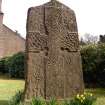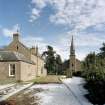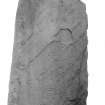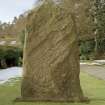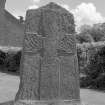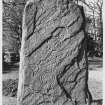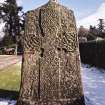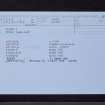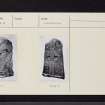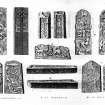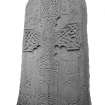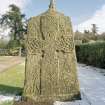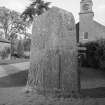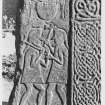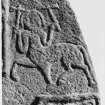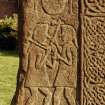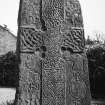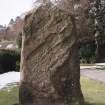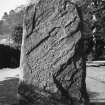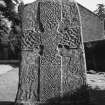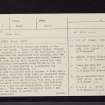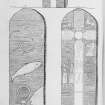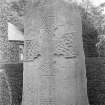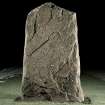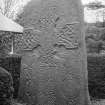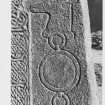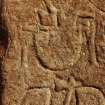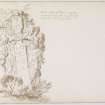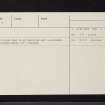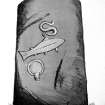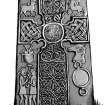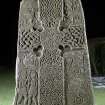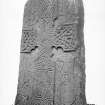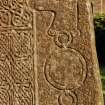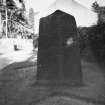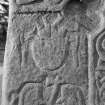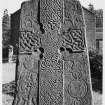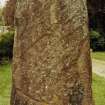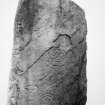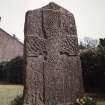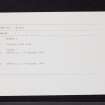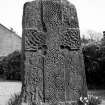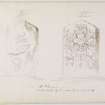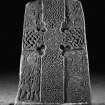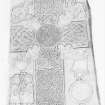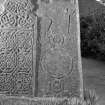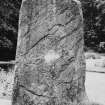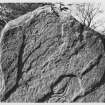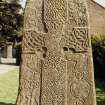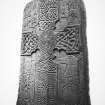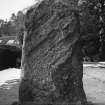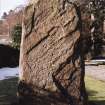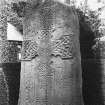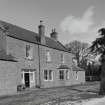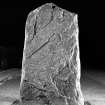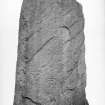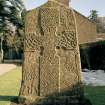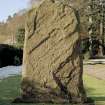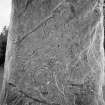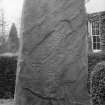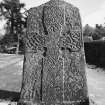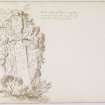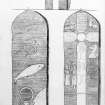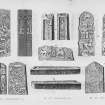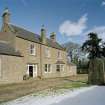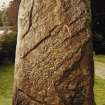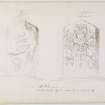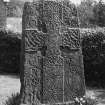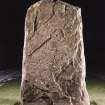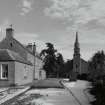Glamis
Cross Slab (Pictish), Pictish Symbol Stone (Pictish)
Site Name Glamis
Classification Cross Slab (Pictish), Pictish Symbol Stone (Pictish)
Alternative Name(s) Glamis No. 2
Canmore ID 32067
Site Number NO34NE 2
NGR NO 38585 46860
Datum OSGB36 - NGR
Permalink http://canmore.org.uk/site/32067
- Council Angus
- Parish Glamis
- Former Region Tayside
- Former District Angus
- Former County Angus
This impressive Pictish cross-slab, probably dating to the 8th century, stands in the garden of the former manse at Glamis (also known as Glamis No.2). On one side it bears an elaborately decorated cross, flanked by four panels with characteristic Pictish carvings, including mythical beasts, a deer and triple disc symbols, and two men fighting with axes set below a cauldron from which two human legs project. On the other side of the stone there is a snake, a fish (probably a salmon) and a mirror.
Information from RCAHMS (SC) 26 July 2007
Carver, M 2005
Glamis 2, Glamis Manse (St Fergus), Angus, Pictish cross-slab
Measurements: H 2.67m +, W 1.68>1.42m
Stone type: sandstone
Place of discovery: NO 3858 4686
Present location: in situ in the front garden of the manse beside the church.
Evidence for discovery: first recorded in the manse garden by Chalmers in the 1840s. The garden is likely once to have been part of the churchyard.
Present condition: some erosion, especially on the uppermost part.
Description
The top of this tapering slab has been dressed into a rough triangular pediment. Face A is carved in a mixture of relief and incision. Filling almost face A is a cross carved in relief and outlined with a roll moulding, with cusped arms and a central roundel. A ring linking the cusps is lightly incised. The lower arm is separated from the shaft only by the difference in their interlace fillings. Above the upper arm and filling the apex of the pedimented top of the slab are traces of two animals. A quadruped with tail curled along its back and bird-like feet faces the upper arm of the cross on the left, while on the right there is a centaur holding aloft an axe in each hand, with its upper body turned to face outwards. Alongside the lower arm and shaft of the cross on the left are two motifs: a cauldron hanging from a stand with two pairs of human legs protruding from the cauldron, above two men in tunics menacing one another with axes in their right hands. To the right an exquisite dog’s head symbol nuzzles the cusp of the lower arm of the cross, a double scroll indicating the muscle below the ear. It appears to be balanced upon a triple disc or cauldron symbol. Incised one above the other on the rough surface of face C are a serpent, a salmon and a mirror symbol with double-disc handle.
Date range: seventh century.
Primary references: ECMS pt 3, 221-2, no 2; Fraser 2008, no 61.1.
Compiled by A Ritchie 2016
NO34NE 2 3858 4686.
(NO 3858 4686) Stone (NAT)
OS 6" map, (1959)
This nearly 9' high cross-slab stands in the grounds of the manse. Early writers, Gordon, Pennant and Knox describe it as being in the churchyard, but it is possible that the churchyard once extended into the manse garden. The slab may have been moved, however, a number of holes at its base possibly indicating some sort of levering instruments being fitted to it. (J Stirton 1913) Traditionally, it was erected to commemorate the assassination of King Malcolm. (L M Angus-Butterworth 1967)
One side is incised with a serpent, a fish, and a mirror symbol, while the other bears an elaborate cross, the side panels beyond it containing a centaur, a dog- like beast, a pair of men fighting with axes, a doe's head, a cauldron (from which a pair of legs protrude) supported on a bar by two ring-handles, and a triple disc symbol. The stone was orginally Class I and re-used in the Class II period. (I Henderson 1960)
J R Allen and J Anderson 1903; J Stirton 1913; I Henderson 1960; R W Feachem 1963; L M Angus-Butterworth 1967; RCAHMS 1983
Field Visit (16 December 1969)
This cross slab is as described and illustrated.
Visited by OS (W D J) 16 December 1969.
Note (1983)
Glamis NO 3858 4686 NO34NE 2
An impressive Class II Pictish cross-slab about 2.7m high, which stands in the manse garden at Glamis; incised on the back there is a serpent, a fish and a mirror. This stone may have been moved from its original position.
RCAHMS 1983
(Gordon 1726, 162-3; Pennant 1774-6, ii, 173; Stuart 1856, 26, plate lxxxiv; Jervise 1857b, 247-8; Allen and Anderson 1903; iii, 221-3; Stirton 1913, 11-12; Henderson 1958, 60; Coutts 1970, 58, no. 14).
Field Visit (1986)
Publication Account (1987)
These two slabs share the distinction of illustrating the two main strands of Pictish decorative layout on opposing faces-one side of each bearing only symbols, the other side a cross with carved motifs in a wide range of iconography including symbols. The stone in the manse garden is far superior in artistic quality, at least to a modem eye, to the other, and it is interesting that they should both bear the serpent and the triple disc symbols.
One side of the slab in the garden bears three Pictish symbols on its rough and irregular surface: a serpent, a fish and a mirror. The sides and top have been shaped so that the slab tapers towards a pedimented head, 2.7 m high, but there is no decoration on the sides. The other face is carved with a cross in relief, entirely infilled with various interlaced designs. An odd feature of this cross is the presence of an incomplete incised ring linking the arms on all but the lower right quadrant, where the muzzle of the dog's head lies in the way, as if the addition of the ring had been a unsuccessful afterthought. Beneath the dog is a triple disc symbol, itself overlapping the dog. On the other side of the cross-shaft, two bearded men confront each other with axes, while above them is a cauldron with two pairs of legs sticking up. This may be part of a Pictish folktale, or it may be linked with the historically documented Pictish tradition of execution by drowning. Flanking the top of the cross are an animal and a centaur brandishing axes, and traces of animal heads may just be seen above the top of the cross.
Within the vestibule of the church, on a window ledge, is a fragment of another cross-slab, showing the interlace-filled base of the cross-shaft and the lower parts of a man and an animal.
The rough face of the slab on Hunters Hill bears an animal, a serpent and a mirror. The other side is sculpted in relief with an interlace-filled cross within a key-pattern frame. The background carvings include a winged figure, a beast-headed figure with an axe, several animals, a triple disc symbol and a flower symbol.
Information from ‘Exploring Scotland’s Heritage: Fife and Tayside’, (1987).
Reference (1997)
Class II symbol stone - Glamis 2 - On the face is a cross with two figures fighting beside which is a cauldron in which there appears to be a figure. Below is a deer's head over a triple disc. On the reverse are a vertical arrangement of a serpent over a salmon and a mirror.
A Mack 1997.
Photographic Survey (20 February 2002)
Measured Survey (July 2003)

















































































